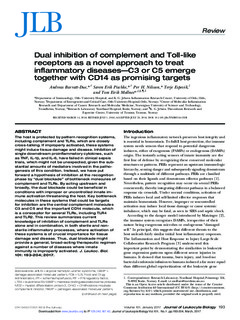| dc.contributor.author | Barratt-Due, Andreas | |
| dc.contributor.author | Pischke, Søren Erik | |
| dc.contributor.author | Nilsson, Per | |
| dc.contributor.author | Espevik, Terje | |
| dc.contributor.author | Mollnes, Tom Eirik | |
| dc.date.accessioned | 2017-10-31T08:03:23Z | |
| dc.date.available | 2017-10-31T08:03:23Z | |
| dc.date.created | 2017-01-27T14:05:03Z | |
| dc.date.issued | 2016 | |
| dc.identifier.citation | Journal of Leukocyte Biology. 2016, . | nb_NO |
| dc.identifier.issn | 0741-5400 | |
| dc.identifier.uri | http://hdl.handle.net/11250/2463029 | |
| dc.description.abstract | The host is protected by pattern recognition systems, including complement and TLRs, which are closely cross-talking. If improperly activated, these systems might induce tissue damage and disease. Inhibition of single downstream proinflammatory cytokines, such as TNF, IL-1β, and IL-6, have failed in clinical sepsis trials, which might not be unexpected, given the substantial amounts of mediators involved in the pathogenesis of this condition. Instead, we have put forward a hypothesis of inhibition at the recognition phase by “dual blockade” of bottleneck molecules of complement and TLRs. By acting upstream and broadly, the dual blockade could be beneficial in conditions with improper or uncontrolled innate immune activation threatening the host. Key bottleneck molecules in these systems that could be targets for inhibition are the central complement molecules C3 and C5 and the important CD14 molecule, which is a coreceptor for several TLRs, including TLR4 and TLR2. This review summarizes current knowledge of inhibition of complement and TLRs alone and in combination, in both sterile and nonsterile inflammatory processes, where activation of these systems is of crucial importance for tissue damage and disease. Thus, dual blockade might provide a general, broad-acting therapeutic regimen against a number of diseases where innate immunity is improperly activated. | nb_NO |
| dc.language.iso | eng | nb_NO |
| dc.publisher | Society for Leukocyte Biology | nb_NO |
| dc.rights | Navngivelse 4.0 Internasjonal | * |
| dc.rights.uri | http://creativecommons.org/licenses/by/4.0/deed.no | * |
| dc.title | Dual inhibition of complement and Toll-like receptors as a novel approach to treat inflammatory diseases-C3 or C5 emerge together with CD14 as promising targets | nb_NO |
| dc.type | Journal article | nb_NO |
| dc.type | Peer reviewed | nb_NO |
| dc.description.version | publishedVersion | nb_NO |
| dc.source.pagenumber | 13 | nb_NO |
| dc.source.journal | Journal of Leukocyte Biology | nb_NO |
| dc.identifier.doi | 10.1189/jlb.3VMR0316-132R | |
| dc.identifier.cristin | 1439419 | |
| dc.relation.project | Stiftelsen Kristian Gerhard Jebsen: SKGJ-MED-012 | nb_NO |
| dc.relation.project | Norges forskningsråd: 223255 | nb_NO |
| dc.description.localcode | © The Author(s). This is an Open Access article distributed under the terms of the Creative Commons Attribution 4.0 International (CC BY 4.0) (http://creativecommons.org/licenses/by/4.0/) which permits unrestricted use, distribution, and reproduction in any medium, provided the original work is properly cited. | nb_NO |
| cristin.unitcode | 194,65,15,30 | |
| cristin.unitcode | 194,65,15,0 | |
| cristin.unitname | Centre of Molecular Inflammation Research (SFF-CEMIR) | |
| cristin.unitname | Institutt for kreftforskning og molekylær medisin | |
| cristin.ispublished | true | |
| cristin.fulltext | original | |
| cristin.qualitycode | 1 | |

